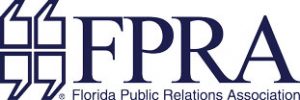By Crystal Rothhaar, director of Communications at Senior Friendship Centers in Sarasota
Member of the Central West Coast Florida Chapter
In the General Session “Mind the Gap: Women’s Leadership in Public Relations,” Tina McCorkindale, Ph.D., APR, president and CEO of the Institute for Public Relations and Rebecca Rickert, director of global communications at Prudential Financial shared the results of focus groups and an industry-wide survey conducted by the Institute of Public Relations and KPMG.
This ongoing study explores what drives the male-female leadership gap that is widely recognized across the business world and in our profession, including work-life fit, unconscious biases, workplace policies and practices.
In an industry that more than 75% women, just 20% occupy senior level leadership positions in PR. A lot of research has been done about inequalities in the workplace between men and women, but most current research doesn’t address PR and communications.
What can we do about it?
The first phase of the research study consisted of 60 participants in focus groups. Five of the focus groups were mid-level females, three were senior-level females, and two were senior and mid-level males.
The second phase of the research is still underway, and consists of a quantitative survey of the public relations industry to gain more knowledge into challenges and opportunities. So far the sample size is 670 people with about a week left to gather information. The presentation at conference is a preliminary view of some of the findings of the second research phase.
The research so far has found that chemistry between mentors and their proteges is everything: most formal mentorship programs are not as effective as informal programs as they may feel forced.
What does a mentor look like?
- 20% have never had a mentor
- Of the remaining 80%, almost 40% say their mentor was their supervisor
- 70% same race/ethnicity, 65% same gender – it’s rare for people to pick mentors who are not like them. We pick people who are the most like us.
Sponsorships are crucial for mobility in a career, and while having a supervisor as a mentor is beneficial, informal relationships are the place where we can find the most growth. The chemistry gained from a casual relationship helps people to share experiences and learn from one another.
In the survey, many senior level women said that mentorship programs are relatively new and that they didn’t have access to them as they were growing in their careers. Mentorship programs in the workplace are much more common today. Women also reported that programs on how to be a better mentor would be helpful, and that there has been a positive shift of women helping women.
Mentorship has far reaching impacts:
- 40% said it helped them receive promotion
- 80% said it enhanced confidence
- 50% say their organization encourages senior leaders to mentor
Likely because of the #MeToo movement, male managers may be shying away from mentoring programs. 60% of male managers say they are uncomfortable doing mentoring, socializing, or having one on one meetings with women. This percentage rose from 46% last year.
We need to push ourselves to reach out for mentors who are not just like us.
What makes a good leader?
- Speaking the language of business
- Walking the talk
- Espousing all the qualities attributed to strong leadership
Being passive-aggressive is a quality of a poor leader.
The demands of the job weigh heavily on both sexes.
- 75% say they often work after hours
- Only 12% say their orgs do not want them checking emails after hours
- 71% agree or strongly agree that their org gives sufficient vacation time
This can cause a sense of burnout, and we have a long way to go to improve work life integration. Some women have indicated that they don’t want to be CEO if it means dedicating more time than they already are.
Because of their common role as caretakers, more women than men report that they need more flexibility. Many times this flexibility comes from a supervisor, not from an organization. This means that we need to think about our own leadership style and how we can become more flexible as leaders.
Organizations can take advantage of work hours, which can be too much:
- ½ say their orgs want them to check email on vacations
- Only 26% say they set clear boundaries about availability after hours
- Nearly 25% say leaders in their orgs are poor role models of flexibility around work life balance and PTO
People don’t just want flexibility, money matters too:
- 54% say they’ve experienced pay discrimination based on gender
- 37% believe men make a higher salary than women in a similar cohort
Addressing potential pay gaps is a must to achieve equality. We need to lift the taboo and talk about money.
- 44% say they’ve discussed compensation with peers, 43% have discussed with leaders
- 56% have asked for pay increase
- Only 23% say they’ve requested salary ranges from HR, 67% say they’ve researched bands
- 65% say they’ve received a competitive offer to increase salary/benefits or standing within their organizations
Gender stereotypes persist
- 60% say they’ve seen gender bias. Only 15% say they’ve never seen it.
- 26% say they rarely see it, 29% never, 45% say sometimes/often/always
- Nearly 25% said there are obstacles to D&I in their company
Some respondents indicated that perceptions differ when a male vs a female leader is being assertive. Many women and men feel a boys club still exists. Many men didn’t feel like there were gender barriers for them to rise; most women said there were.
Benefits and policies create opportunity
- Only 55% said their companies offer paternity leave, 92% offer maternity leave
- 67% say flex work arrangements are “very” important to them
- 86% leadership training programs are important to them
Some women were frustrated by the lack of organizational support given to them for professional development programs in leadership training. Leaves of absence carry a stigma.
- 45% say a leave would hurt their careers
- 78% say they’d be recharged after taking a leave
Call to action happens now
Gender equality is for women and men:
- Both men and women cited the importance of joining together to increase equality and inclusiveness in their organizations and the industry
- Women and men agreed that change needs to happen and happen now
- Open discussions with men and women at all levels about diversity and inclusion in the workplace is essential to progress
Organizations need to address potential pay gaps
Both men and women felt that gender pay disparity is improving but must be addressed systematically. Consistently reviewing organization-wide compensation would help address any pay gaps and inconsistencies in those doing equal work.
Women not negotiating as well is not a good excuse.
Leaders must prioritize action
- Change starts at the top – C suites need to ensure their boards and practices reflect the diversity they seek to embed throughout the organizations
- Must acknowledge there is still a gender leadership imbalance and work together to dive change in policy and behaviors
- Leaders must set an example for their teams in terms of work-life fit
Take charge of yours and others careers
- Seek out sponsors and peer networks to help support you and your career goals
- Engage in professional development activities, understand the business, and evolve skills and abilities that will help advance your career
- Institute a cycle of mentorship/sponsorship. Help mentor or sponsor others to help them grow in their careers
- Find a mentor who is not your supervisor
Review policies and make organizational change
- Organizational policies should be reviewed regularly to ensure that both women and men are granted equal opportunities
- Unconscious bias classes are beneficial, but there needs to be ongoing programming rather than one-off training
- Encourage informal mentorships and sponsorships.
Other recommendations from respondents
- Transparency around diversity numbers and compensation
- Industry awards and recognition of success
- Changing leadership mindset – be intentional
The researchers suggest reading a study called “Fixing the flawed approach to diversity” by the Boston Consulting Group. This study takes into consideration gender, color and LBGTQ. It shows different challenges for different groups.
This session provided information that can help organizations and practitioners make meaningful steps to improve diversity and inclusion.


